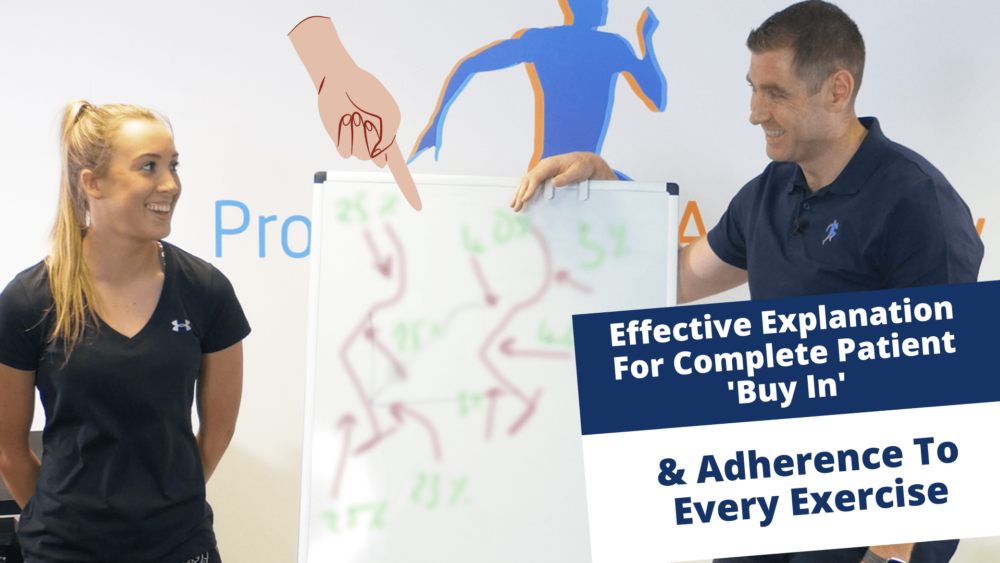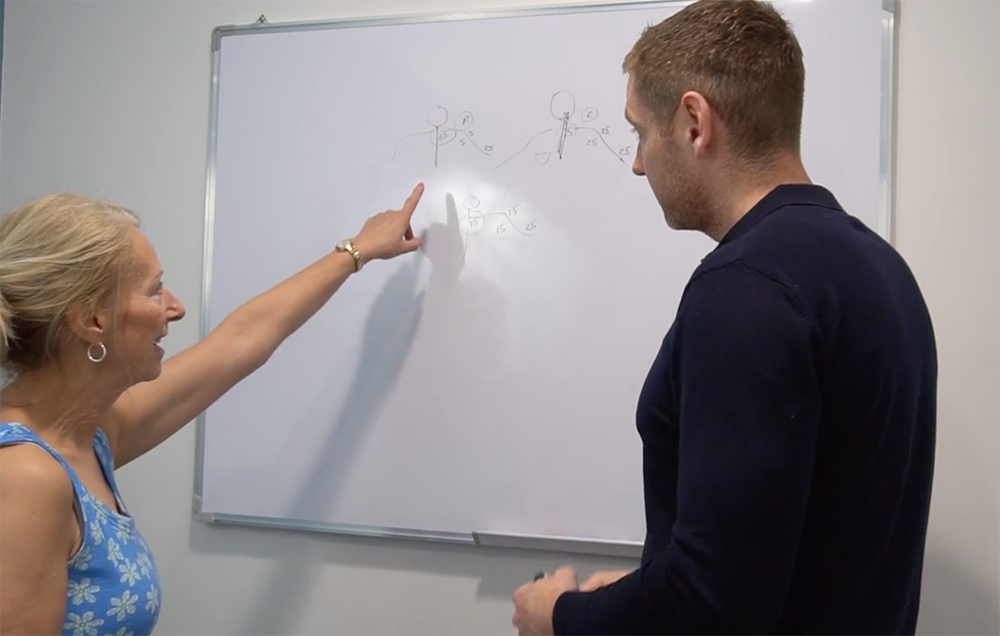Effective Explanation For Complete Patient ‘Buy In’ & Adherence To Every Exercise
In ‘How To Make Sense Of The Objective Assessment – Part 3’ we covered testing and how to check your patient’s ability to tolerate load in specific directions.
The skills we have outlined for your subjective assessment and objective assessment are powerful tools to help you understand your patient’s condition. If you understand those pillars then you are ready to progress…
You may feel ready to progress, but is your patient? To fully progress together you need to ensure full ‘buy-in’ and adherence to every exercise in your treatment plan.
The first step in the treatment process is an effective explanation. Pain neuroscience education has become very popular amongst therapists on social media over the last few years.
However, the reality is that when a person is in front of a therapist it is a lot harder to implement than it sounds online. Many therapists are left frustrated by the inability to get the message through to the patient who, after their best efforts, may respond with something like ‘so, your saying it’s all in my head?’.
The harsh reality is that patients don’t really care about pain neuroscience. All patients care about is getting back to what motivated them to come in the first place.
Think about that for a second. A patient is motivated to take action to find a solution for their problem and sought your services for this very reason.
At the end of the day, what a patient really wants to know is what they need to do to get back to what they want to be able to do again.
If you are a non ‘Go-To’ Therapist and just like the subjective assessment, where you’ve been focusing on the site of pain and the symptoms, the first words out of your mouth may be the diagnosis.
Patella Tendonosis, sciatica, piriformis syndrome…
Once you tell your patient this information, where does their attention go?
What do they tell their partner at home?
What do they then google when they go home, because, let’s be honest, they have no idea what that actually means and the second they hear words that are not familiar a subconscious barrier comes up.
The more words in an explanation that a person does not understand, the less confident they will be in gaining understanding and they will give up actively trying.
Think about it…
Recall the last time you read a scientific paper or book that had some words that you didn’t understand, or someone tried to explain something and after a few seconds in, you heard two to three words that you were not familiar with and it went way over your head and you naturally started to zone out…
Instead the ‘Go-To’ Therapist opts for EFFECTIVE EXPLANATION of the actual problem.
There is a big difference between the problem versus the diagnosis.
The diagnosis would be a Patella Tendonosis but the problem is the hamstring is not working under isometric-like conditions efficiently due to a previous hamstring injury, so the quadriceps are working excessively when decelerating and overloading the patella tendon.
If the person understands the problem, they will then be clear on WHY they are doing an exercise to allow the hamstring an opportunity to work under isometric-like conditions again; from my experience, you will have a far greater chance of patient adherence.
We can still educate the patient on pain neuroscience but rather than use medical words, we use simple terms with the help of diagrams for visual understanding of how the quad muscles are working too hard and putting too much pressure on the knee joint…
…therefore the knee joint is becoming a bit annoyed and sending messages up to the brain that it is doing way too much work because that lazy hamstring is not doing enough work.
If A Person Understands The Problem, Then The Next Logical Step Is To Find Out The Solution ‘Buy In’ &Amp; Adherence To Every Exercise
Now what happens is the knee joint actually becomes the GOOD guy and is no longer the victim. This completely changes the patient’s perception then of the body part that is in pain, from my experience.
This works brilliantly with back pain patients who think their backs are weak. We then make them realise that their low back is actually doing way too much work because their mid-back or hips, or whatever is the specific problem to the patient, is not doing enough.
The person’s perception and relationship with their back then instantly changes and false beliefs and misconceptions are broken effortlessly.
The patient will usually be able to feel the difference in energy expenditure to absorb loads in the directions where there are ‘perceived threats’ to the system identified in the objective assessment. This will help with the ‘buy-in’ of the treatment and rehabilitation plan when you are delivering your explanation.
I usually get a lot of ‘That makes sense’ comments from patients after my explanation, as it is very specific to their story and they can now see how their body has adapted as a result of previous injuries or emotional stressors.
Once the patient understands the problem, they now need to understand the solution.
This is where the ‘Go-To’ Therapist will explain the step-by-step progressions that need to happen to get that patient back to meaningful activities for them.
The patient will be clear on why they are doing certain exercises but will also understand why they are doing certain things before being able to run, for example.
At the end of the explanation, the patient should be clear on the true problem and what needs to be done to rectify this problem and the step-by-step progressions so that they don’t ‘try’ progress themselves too quickly.
I will then usually give the patient a prognosis of how many sessions this will usually take, based on previous experience, so I can set expectations from the first session.
The final and yet arguably the most important question after informing the patient of how long roughly this will take to resolve is ‘Is that what you were expecting?’.
This is a great question to avoid having to address any misaligned expectations for the patient that may show up in the second or third session. I’d rather address these issues in the first session along with any objections from the patient in order to leave the path clear to focus completely on getting that patient the meaningful impact.
It may intimidate some therapists to give a prognosis, but professional sports physiotherapists have to do this day in and day out and once you have the confidence and clarity of what has to happen to get the patient the result they want, then this actually works to your advantage.
The other benefit to doing this is it also makes you accountable and focused on the objective of each session.
If you are not where you need to be by session 3, then you may have missed something or haven’t found the true stressor. Or you have been ineffective in your treatment stimulus to desensitise what needs to be desensitised.
The great thing is, if your explanation was effective, you might actually see the patient’s physiology start to change before your eyes.
Physically what is happening, or certainly what I think is happening, is the tone in the diaphragm and pelvic floor relaxes which results in a more slouched position when sitting (which is a good thing by the way!) and the ribcage starts to depress more naturally as the person starts to shift towards the parasympathetic nervous system or ‘rest and digest’.
Do you see how important clear explanation and communication is in getting complete patient ‘buy in’ and adherence to every exercise you provide? In the next part we will delve into pillar 4 of the go-to therapist pillar system and discuss the 80/20 Rule Of Physical Therapy & Designing An Effective Treatment Plan for your patient.



